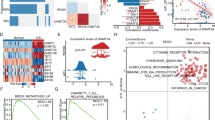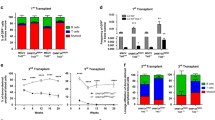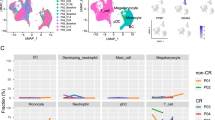Abstract
BCL6, a master transcription factor for differentiation of follicular helper T (TFH) cells, is highly expressed in angioimmunoblastic T-cell lymphoma (AITL) and peripheral T-cell lymphomas (PTCL) containing tumor cells with TFH features. TET2, encoding an epigenetic regulator, is frequently mutated in AITL/PTCL. We previously reported that Tet2 knockdown mice developed T-cell lymphomas with TFH features. Hypermethylation of the Bcl6 locus followed by BCL6 upregulation was thought to be the key event for lymphoma development in mice. The mechanisms by which BCL6 expression is upregulated in human AITL/PTCL, however, have not been elucidated. Here, we investigated the impact of TET2 mutations on methylation of BCL6 locus in human AITL/PTCL samples. Hypermethylation of the BCL6 locus was more frequent in PTCL samples than B-cell lymphoma samples (PTCL vs B-cell lymphomas: 9/42 vs 0/35). PTCL samples with TET2 mutations were more frequently hypermethylated than those without TET2 mutations (PTCL with TET2 mutations vs without mutations: 6/22 vs 0/17). BCL6 expression in hypermethylated samples was higher than that in low methylated samples. Deregulated BCL6 expression caused by hypermethylation and TET2 mutations may result in skewed TFH differentiation and eventually contribute to AITL/PTCL development in patients, as well as lymphoma development in Tet2 knockdown mice.
Similar content being viewed by others
Avoid common mistakes on your manuscript.
Introduction
Angioimmunoblastic T-cell lymphoma (AITL) is a distinct subtype of peripheral T-cell lymphoma (PTCL), having specific clinical features, including generalized lymphadenopathy, high fever, skin rash, and autoimmune-like manifestations [1]. AITL tumor cells express proteins commonly found in follicular helper T cells (TFH cells) [1]. Among them, B-cell lymphoma protein 6 (BCL6) is of particular interest due to its role as a fate determinant of TFH cells [2, 3]. The mechanisms of BCL6 upregulation in AITL have not been clarified. Some peripheral T-cell lymphomas exhibit several features reminiscent of AITL, having tumor cells with TFH features, i.e., BCL6 expression (nodal PTCL with TFH phenotype) [4–6].
We and others discovered specific genomic structures in AITL [7–9]. Loss-of-function mutations in Ten Eleven Translocation (TET2) was extremely frequent: 33–83% of AITL and 20–49% of PTCL-NOS. Mutations in ras homolog family member A (RHOA), isocitrate dehydrogenase 2 (IDH2), and DNA methyltransferase 3A (DNMT3A) were also found in 63–71, 20–45, and 26–33% of AITL and 17, 0, and 27% of PTCL-NOS, respectively [7–9].
TET2 gene encodes a methylcytosine dioxygenases, converting 5-methylcytosine (5mC) to 5-hydroxymethylcytosine (5hmC), 5-formylcytosine (5fC), and 5-carboxylcytosine (5caC) [10]. These modified cytosines regulate gene expression by mediating active and passive demethylation processes, and functioning as epigenetic marks [10]. Although impairment of catalytic activity by TET2 mutations abrogates cytosine modification, it remains to be elucidated whether the methylation profiles are actually affected by TET2 mutations in human AITL samples. IDH2 mutants inhibit function of TET enzymes through production of hydroxyglutarate. IDH2-mutated PTCL samples were shown to display hypermethylation [11]. We previously reported that Tet2 knockdown mice developed T-cell lymphomas with TFH features, partially recapitulating human AITL, at very long latencies [12]. Genome-wide methylation analysis identified hypermethylation at intron 1 of Bcl6 locus, along with high expression of BCL6 [12]. BCL6 expression was decreased as a consequence of demethylation process by treatment of a hypomethylating agent [12]. This study suggests that hypermethylation of Bcl6 may be a key event for development of T-cell lymphomas with TFH features in Tet2 knockdown mice.
Here, we clarify the methylation status of BCL6 locus in human AITL samples and the impact of TET2 mutations.
Methods
Patients and samples
Samples were obtained from 42 PTCL patients with AITL (n = 23) and PTCL-NOS (n = 19) (Supplemental Table 1), and 35 B-cell lymphoma patients with diffuse large B-cell lymphoma (DLBCL, n = 22) and follicular lymphoma (FL, n = 13) (Supplemental Table 2). These samples were used after approval by the local ethics committees in all the participating institutes. Genomic DNA was extracted from 16 fresh frozen samples using Puregene DNA blood kit (Qiagen) and 26 Periodate-Lysine-Paraformaldehyde (PLP)-fixed frozen samples using FFPE tissue kit (Qiagen).
Bisulfite PCR
Extracted genomic DNA was subjected to bisulfite conversion using an EpiTectPlus Bisulfite Kit (Qiagen) following the manufacturer’s instructions. PCR primers for CpG islands 27 and 39 in BCL6 locus were designed by the Methyl Primer express software (Supplemental Table 3, Fig. 1). Three microliters of DNA were used for polymerase chain reaction (PCR) under the following conditions: 94 °C for 1 min, 40 cycles of 94 °C for 30 s, 54 °C for 30 s, 72 °C for 1 min, and 72° for 2 min by ExTaq (Takara Bio) with each primer set. PCR amplicons were used for targeted methylation analysis.
Targeted methylation analysis
The libraries were made from bisulfite polymerase chain reaction (PCR) products using the Ion Plus Fragment Library kit (Thermo Fisher scientific) as previously described [13]. Briefly, PCR amplicons were ligated to barcode adapters and P1 adapters, and then amplified. Quantitation of the amplified libraries was performed by quantitative PCR with the Ion Library Quantitation kit according to the manufacturer’s instruction (Thermo Fisher scientific). The libraries were then subjected to high-throughput sequencing on Ion PGM according to the standard protocol for 300 base pair single-end reads (Thermo Fisher scientific). Data were analyzed using Variant caller 3.4 (Thermo Fisher scientific). Hypermethylation was defined by the average methylation levels of 5.5% or higher.
Subcloning of PCR product
Bisulfite PCR products were subcloned using pGEM®-T easy vector system (Promega). Plasmid DNA was extracted from at least 12 colonies and subjected to direct sequencing on ABI 3130 (Thermo Fisher scientific).
Immunohistochemical staining
Periodate-Lysine-Paraformaldehyde (PLP)-fixed frozen samples were cut in a cryostat at −22 °C into 5-μm sections and mounted on MICRO SLIDE GLASS (MATSUNAMI GLASS). Tissue sections were stained with mouse anti-human BCL6 (PG-Bbp 20010946, Dako) diluted 1:75 and detected by Envison™+ Dual Link system-HRP (Dako). Then, tissue sections were counterstained with Hematoxylin (Mayer Hematoxylin, Muto Pure Chemical Co., Ltd) in 30 s at room temperature. After staining, tissue sections were dehydrated with ethanol and enclosed using MOUNT-QUICK (DAIDO SANGYO). Images were obtained by OLYMPUS BX50 (OLYMPUS).
Statistical analysis
All data were analyzed using the SPSS software. Statistical significance was calculated using a Fisher’s exist test. p values <0.05 were considered statistically significant.
Results
Methylation of BCL6 locus in PTCL
To examine the methylation status of BCL6 locus in human AITL samples, methylation levels of BCL6 locus at the CpG islands 27 and 39 were determined by bisulfite sequencing followed by deep sequencing for 23 AITL and 19 PTCL-NOS samples. The methylation levels were higher than the cut-off value in 7 and 9 out of 42 samples at the CpG islands 27 and 39, respectively (Fig. 2; Supplemental Table 4, Supplemental Fig. 1). Methylation levels were not different between AITL and PTCL-NOS samples (AITL vs PTCL-NOS: CpG27, 5/23 vs 2/19, p = 0.428, CpG39, 7/23 vs 2/19, p = 0.149) (Supplemental Fig. 2). Hypermethylation of intron1 of BCL6 locus was previously reported in human B-cell lymphoma. In our cohort, the methylation levels were high only in 1 out of 34 B-cell lymphoma samples at the CpG island 27, while none of the B-cell lymphoma samples have hypermethylation at the CpG island 39 (Fig. 2; Supplemental Table 5). Hence, hypermethylation of BCL6 locus was more frequent in PTCL samples than B-cell lymphoma samples (PTCL vs B-cell lymphoma: CpG27, 7/42 vs 1/34, p = 0.068; CpG39, 9/42 vs 0/35, p = 0.030).
Impact of TET2 mutations on methylation status of BCL6
We previously reported that CD4-positive splenic T cells of Tet2 knockdown mice exhibit hypermethylation of Bcl6 locus [12]. To see the impact of TET2 mutations on BCL6 locus, mutational status of TET2 was examined in 39 PTCL samples (23 AITL and 16 PTCL-NOS samples). Forty TET2 mutations were found in 22 out of 39 PTCL samples (AITL 30, PTCL-NOS 10, Supplemental Table 6. Twenty-nine out of forty TET2 mutations were previously described [7]. Eleven TET2 mutations are in submission by Tran B. Nguyen, et al.). The methylation levels were high in 6 and 8 out of 22 PTCL samples with TET2 mutations at the CpG islands 27 and 39, respectively. In contrast, the methylation levels were high in none and only 1 out of 17 PTCL samples without TET2 mutations at the CpG islands 27 and 39 (Fig. 3). Thus, hypermethylation was more frequent in PTCL samples with TET2 mutations than those without TET2 mutations (PTCL with TET2 mutations vs PTCL without TET2 mutations: CpG27, 6/22 vs 0/17, p = 0.027; CpG39, 7/22 vs 1/17, p = 0.106). Among AITL, 5 out of 17 samples with TET2 mutations had hypermethylation, while none of the samples without TET2 mutations had hypermethylation (AITL with TET2 mutations vs AITL without TET2 mutations: CpG27, 5/17 vs 0/6, p = 0.272; CpG39, 6/17 vs 1/6, p = 0.621, PTCL-NOS with TET2 mutations vs PTCL-NOS without TET2 mutations: CpG27, 1/5 vs 0/11, p = 0.217; CpG39, 1/5 vs 0/11, p = 0.217) (Supplemental Fig. 3).
Impact of IDH2 mutations on methylation status of BCL6
IDH2 mutations were reported to affect methylation status in human AITL samples [11]. Among 22 TET2-mutated PTCL samples, IDH2 mutations coexisted in five samples, while PTCL samples without TET2 mutations did not have IDH2 mutations (Supplemental Table 6). The methylation levels were high in one and two out of five PTCL samples with TET2 and IDH2 mutations at the CpG islands 27 and 39. Meanwhile, the methylation levels were high in 4 out of 16 PTCL samples without IDH2 mutations at the CpG islands 27 and 39. Thus, IDH2 mutations did not have additional effect on BCL6 methylation status (PTCL with TET2 and IDH2 mutations vs PTCL with TET2 mutations and without IDH2 mutations: CpG27, 1/5 vs 4/16, p = 1; CpG39, 2/5 vs 4/16, p = 0.598) (Fig. 4).
Correlation between BCL6 expression and methylation status
BCL6 was highly expressed in mouse lymphoma samples with hypermethylation of BCL6 locus [12]. Thus, we examined the relationship between BCL6 expression and methylation status. All five PTCL samples with hypermethylation highly expressed BCL6 protein, while 6 out of 16 PTCL samples without hypermethylation highly expressed BCL6 (PTCL with hypermethylation vs without hypermethylation, 5/5 vs 6/16, p = 0.045, Table 1).
Discussion
Here, we demonstrate that hypermethylation at intron1 of BCL6 is frequently observed in AITL and PTCL-NOS, especially when the samples have TET2 mutations. Furthermore, BCL6 is highly expressed in hypermethylated samples.
Some PTCL samples with TET2 mutations did not show hypermethylation. AITL and PTCL-NOS tumor tissues may contain not only tumor cells but also massive infiltration of inflammatory cells. Consequently, the methylation levels of tumor tissues may display lower than those of tumor cells. Allele frequencies of TET2 mutations are different among samples. Actually, the samples whose allele frequencies of TET2 mutations were low tended to have low methylation levels (data not shown). It would be a future study to examine the methylation levels in purified tumor cells.
BCL6 functions as a transcriptional repressor, composed of a BTB/POZ domain binding to repressor proteins and a zinc finger domain binding to DNA, respectively [14]. Physiologically, BCL6 has been well known to function as a key regulator for germinal center B cells [3, 14]. Recent studies highlight the functions of BCL6 in the development and function of several subsets of T cells, including TFH cells [2, 3]. In parallel, BCL6 plays roles in transformation of these cells [3, 14]. The mechanisms of deregulated BCL6 expression have extensively been studied in B-cell lymphoma [14]: chromosomal translocation between BCL6 and immunoglobulin heavy chain (IgH) or non-IgH loci results in upregulation of BCL6 expression under the regulatory regions of high transcriptional activity [15]. Gain of BCL6 locus is assumed to be involved in an early stage of tumor evolution by transient overexpression of BCL6 [16]. Somatic mutations targeting regulatory regions in exon-1 and intron-1 of BCL6 are also known to upregulate its expression [17]. In addition, it was first described in diffuse large B-cell lymphoma that hypermethylation of BCL6 intronic region leads to deregulated BCL6 expression through preventing engagement of enhancer-blocking transcription factor CTCF [18]. However, hypermethylation was quite rare in B-cell lymphomas in our study.
Deregulated BCL6 expression caused by hypermethylation as a consequence of TET2 impairment may result in skewed differentiation towards TFH cells. This may eventually contribute to human T-lymphomagenesis as were found in mouse lymphoma models.
References
de Leval L, Gisselbrecht C, Gaulard P. Advances in the understanding and management of angioimmunoblastic T-cell lymphoma. Br J Haematol. 2010;148(5):673–89.
Nurieva RI, Chung Y, Martinez GJ, Yang XO, Tanaka S, Matskevitch TD, et al. Bcl6 mediates the development of T follicular helper cells. Science. 2009;325(5943):1001–5.
Bunting KL, Melnick AM. New effector functions and regulatory mechanisms of BCL6 in normal and malignant lymphocytes. Curr Opin Immunol. 2013;25(3):339–46.
Rodriguez-Pinilla SM, Atienza L, Murillo C, Perez-Rodriguez A, Montes-Moreno S, Roncador G, et al. Peripheral T-cell lymphoma with follicular T-cell markers. Am J Surg Pathol. 2008;32(12):1787–99.
Lemonnier F, Couronne L, Parrens M, Jais JP, Travert M, Lamant L, et al. Recurrent TET2 mutations in peripheral T-cell lymphomas correlate with TFH-like features and adverse clinical parameters. Blood. 2012;120(7):1466–9.
Swerdlow SH, Campo E, Pileri SA, Harris NL, Stein H, Siebert R, et al. The 2016 revision of the World Health Organization classification of lymphoid neoplasms. Blood. 2016;127(20):2375–90.
Sakata-Yanagimoto M, Enami T, Yoshida K, Shiraishi Y, Ishii R, Miyake Y, et al. Somatic RHOA mutation in angioimmunoblastic T cell lymphoma. Nat Genet. 2014;46(2):171–5.
Palomero T, Couronne L, Khiabanian H, Kim MY, Ambesi-Impiombato A, Perez-Garcia A, et al. Recurrent mutations in epigenetic regulators, RHOA and FYN kinase in peripheral T cell lymphomas. Nat Genet. 2014;46(2):166–70.
Yoo HY, Sung MK, Lee SH, Kim S, Lee H, Park S, et al. A recurrent inactivating mutation in RHOA GTPase in angioimmunoblastic T cell lymphoma. Nat Genet. 2014;46(4):371–5.
Ko M, An J, Rao A. DNA methylation and hydroxymethylation in hematologic differentiation and transformation. Curr Opin Cell Biol. 2015;37:91–101.
Wang C, McKeithan TW, Gong Q, Zhang W, Bouska A, Rosenwald A, et al. IDH2R172 mutations define a unique subgroup of patients with angioimmunoblastic T-cell lymphoma. Blood. 2015;126(15):1741–52.
Muto H, Sakata-Yanagimoto M, Nagae G, Shiozawa Y, Miyake Y, Yoshida K, et al. Reduced TET2 function leads to T-cell lymphoma with follicular helper T-cell-like features in mice. Blood Cancer J. 2014;12(4):e264.
Nguyen TB, Sakata-Yanagimoto M, Nakamoto-Matsubara R, Enami T, Ito Y, Kobayashi T, et al. Double somatic mosaic mutations in TET2 and DNMT3A–origin of peripheral T cell lymphoma in a case. Ann Hematol. 2015;94(7):1221–3.
Basso K, Dalla-Favera R. Roles of BCL6 in normal and transformed germinal center B cells. Immunol Rev. 2012;247(1):172–83.
Lu Z, Tsai AG, Akasaka T, Ohno H, Jiang Y, Melnick AM, et al. BCL6 breaks occur at different AID sequence motifs in Ig-BCL6 and non-Ig-BCL6 rearrangements. Blood. 2013;121(22):4551–4.
Green MR, Vicente-Duenas C, Romero-Camarero I, Long Liu C, Dai B, Gonzalez-Herrero I, et al. Transient expression of Bcl6 is sufficient for oncogenic function and induction of mature B-cell lymphoma. Nat Commun. 2014;2(5):3904.
Pasqualucci L, Migliazza A, Basso K, Houldsworth J, Chaganti RS, Dalla-Favera R. Mutations of the BCL6 proto-oncogene disrupt its negative autoregulation in diffuse large B-cell lymphoma. Blood. 2003;101(8):2914–23.
Lai AY, Fatemi M, Dhasarathy A, Malone C, Sobol SE, Geigerman C, et al. DNA methylation revents CTCF-mediated silencing of the oncogene BCL6 in B cell lymphomas. J Exp Med. 2010;207(9):1939–50.
Acknowledgements
This work was supported by the Grants-in-Aid for Scientific Research (KAKENHI: 16K15497 to M. S.-Y.; and 24390241, 25112703, and 15H01504 to S. C.) from the Ministry of Education, Culture, Sports, and Science of Japan. This work was also supported by Research Grants from the Daiichi Sankyo Foundation of Life Science and the Naito Foundation to M.S.-Y.; and The Uehara Memorial Foundation, Leukemia Research Fund, Takeda Science Foundation, and Kobayashi Foundation for Cancer Research to S.C.
Author information
Authors and Affiliations
Corresponding authors
Electronic supplementary material
Below is the link to the electronic supplementary material.
About this article
Cite this article
Nishizawa, S., Sakata-Yanagimoto, M., Hattori, K. et al. BCL6 locus is hypermethylated in angioimmunoblastic T-cell lymphoma. Int J Hematol 105, 465–469 (2017). https://doi.org/10.1007/s12185-016-2159-z
Received:
Revised:
Accepted:
Published:
Issue Date:
DOI: https://doi.org/10.1007/s12185-016-2159-z








